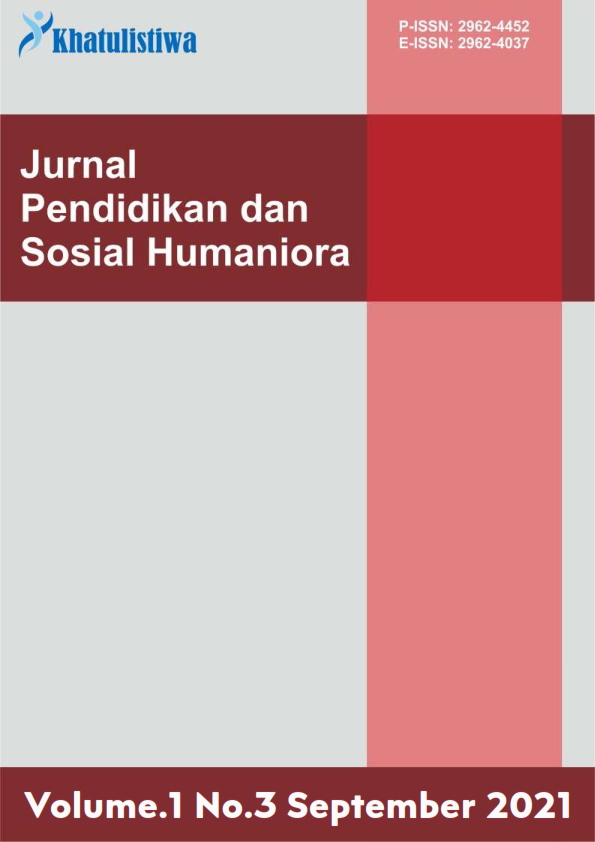PENDIDIKAN ISLAM TENTANG FIGUR WANITA DALAM AL-QUR’AN
ISLAMIC EDUCATION ABOUT WOMEN FIGURE IN THE QUR'AN
DOI:
https://doi.org/10.55606/khatulistiwa.v1i3.532Keywords:
Islamic education, female figure, Al-Qur'anAbstract
The discussion about the female figure has always been an interesting issue and invites pros and cons, especially when it is related to the issue of gender equality. Through the story method, it can be concluded that the stories of women in the Qur'an emphasize an ideal concept of gender equality. The story emphasizes that an achievement in the field of spiritual and professional career does not have to be dominated by one gender only. Women have equal opportunities and abilities with men in achieving, in the political, social, economic fields to education and professional careers. By presenting and re-exploring the moral values of this inspiring woman's story, it is hoped that the women of the millennial era will be able to present a new spirit in building a nation of character.
References
Al Mahalli, J., & As Suyuti, J. (2013). Tafsir Jalalain berikut Asbabun Nuzul. (A. Bahrun dkk, Trans.) Bandung: Sinar Baru Algensindo.
As-Sya'rawi, M. (2009). Fikih Perempuan (Muslimah) : Busana dan Perhiasan, Penghormatan atas Perempuan, sampai Wanita Karier. Jakarta: Amzah.
Burton, R. (2003). The Book of the Thousand Nights and a Night — Volume 01. United Kingdom: Kissinger Publishing Co.
Carens, J. (2000). 6 Muslim Minorities in Contemporary Democracies: The Limitations of Liberal Toleration. New York: Oxford University Press.
Chdan, M. (1991). Adam, Eve, & Satan in the Garden of Eden. The University of Singh Arts Research Journal, 30(1), 25-35.
Encyclopaedia. (2001). Encyclopaedia of the Qur’an. Leidan: Brill.
Ihsan, M. (2012). Filsafat Islam. Jakarta: Griya Ilmu, 2012.
Katsir, I. (2014). Kisah-Kisah Para Nabi. (M. Zaini, Trans.) Surakarta: Insan Kamil Solo.
Masruri, M. (2015). Sejarah Sosial Perempuan dalam Islam: Masa Nabi dan al-Khulafa’a ar-Rasyidin. Yogyakarta: UIN Sunan Kalijaga.
RI, K. (2019). Al-Qur'an dan Terjemahnya. Jakarta: Lembaga Pentashihan Mushaf Al-Qur'an.
Sembodo. (2012). Konsep Pendidikan Islam. Surabaya: Islamuna.
Shihab, M. (1999). “Kata Pengantar Kesetaraan Jender dalam Islam”. In N. Umar, Argumen Kesetaraan Jender Perspektif al-Qur’an. Jakarta: Paramadina.
Soejarno, S. (2010). Pengantar Penelitian Hukum. Jakarta: UI-Press.
Stowasser, B. (2004). Women in the Qur'an: Traditions and. Interpretation. New York: Oxford University Press.
Sukmadinata, N. S. (2011). Metode Penelitian Pendidikan. Bandung: Rosda Karya .
Trible, P., & Russell, L. (2006). Hagar, Sarah, dan their Children: Jewish, Christian, dan Muslim Perspectives. Louisville: Westminster John Knox Press.
Wensinck, A. J. (2012). “Maryam“. Retrieved Juli 4, 2021, from Encyclopaedia of Islam, First Edition (1913-1936): https://referenceworks.brillonline.com/
Zed, M. (2004). Metodologi Penelitian Kepustakaan. Jakarta: Obor Indonesia.
Downloads
Published
How to Cite
Issue
Section
License
Copyright (c) 2022 Khatulistiwa: Jurnal Pendidikan dan Sosial Humaniora

This work is licensed under a Creative Commons Attribution-ShareAlike 4.0 International License.








